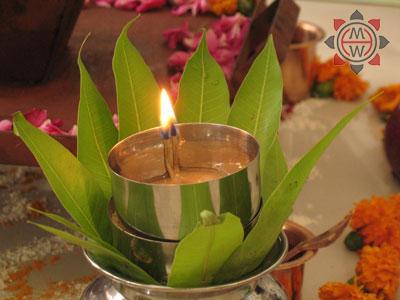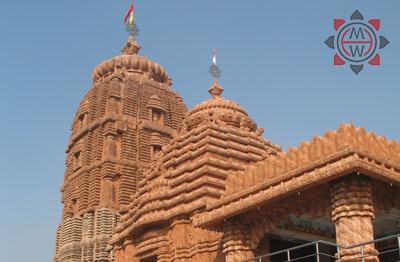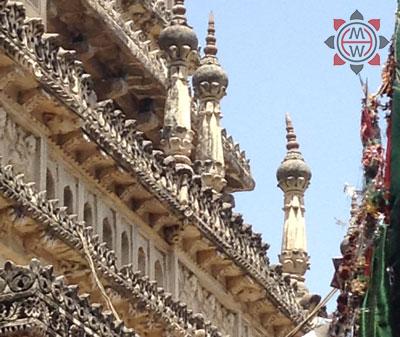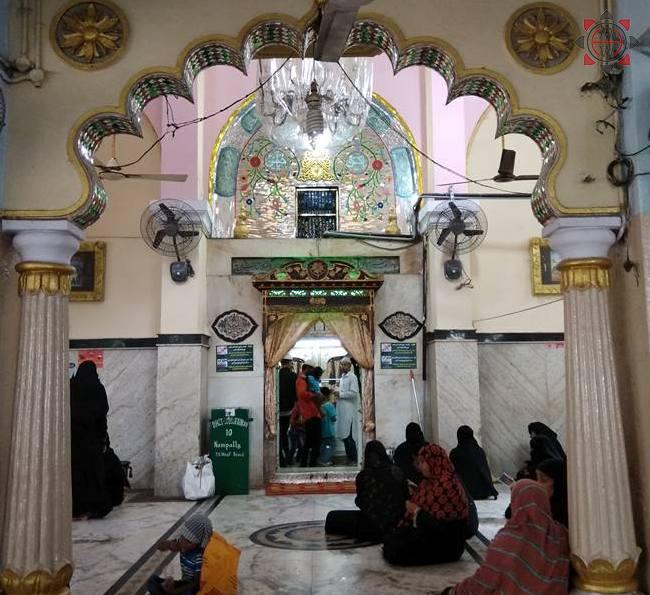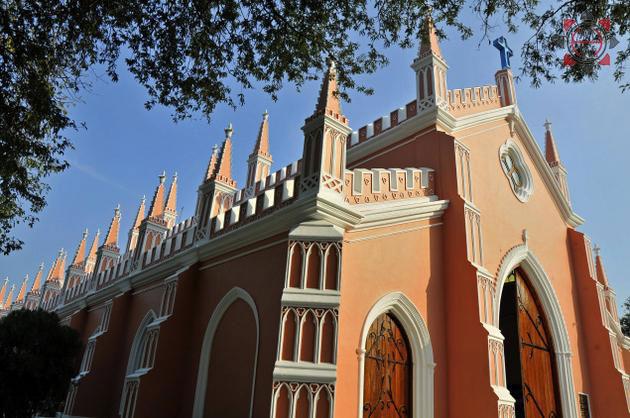To an ardent traveler, Hyderabad offers a fascinating panorama of the past, with a rich mix of cultural and historical tradition spanning 400 colorful years. A treat for lovers of history, art, architecture with several monuments, forts, palaces, ornate tombs, museums, mosques, temples, churches, adorning the city, charming with its tourist spots.
Vantage points
Charminar
The Charminar, constructed in 1591, is a monument and mosque. The landmark has become a global icon of Hyderabad. It is listed as an archaeological and architectural treasure on the official "List of Monuments" prepared by the Archaeological Survey of India. The English name is a translation and combination of the Urdu words Chār and Minar or meenar, translating to "Four Towers"; the eponymous towers are ornate minarets attached and supported by four grand arches. There are various theories regarding the purpose for which Charminar was constructed. However, it is widely accepted that Charminar was built at the center of the city, to commemorate the eradication of plague, a deadly disease which was wide spread at that time.
Golconda fort
Golconda, also known as Golkonda or Golla konda ("shepherd's hill"), a fort of Southern India and capital of the medieval sultanate of the Qutb Shahi dynasty (c.1518–1687). The region is known for the mines that have produced some of the world's most famous gems, including the Koh-i-Noor, the Hope Diamond and the Nassak Diamond. At Fateh Darwaza you can experience a fantastic acoustic effect, characteristic of the engineering marvels at Golkonda. A hand clap at a certain point below the dome at the entrance reverberates and can be heard clearly at the 'Bala Hisar' pavilion, the highest point almost a kilometer away. This worked as a warning note to the royals in case of an attack.
When visiting the fort during the day, wear comfortable footwear to climb 360 steps, apply sunscreen, wear a cap, carry a water bottle.
There is also a light and sound show in the evenings.
Bidar Fort
Bidar Fort is situated in Bidar city of the northern plateau of Karnataka, about 130 kms (3 hours) from Hyderabad. Sultan Alla-Ud Din Bahman of the Bahmanid Dynasty shifted his capital from Gulbarga to Bidar in 1427 and built his fort along with a number of Islamic monuments.
Bidar fort has a number of monuments within the fortress complex. Prominent amongst them are the Rangin Mahal ("Painted Palace"), so called because of its elaborate decoration with coloured tiles; the Takht Mahal, or throne room; the Jami Masjid ("Great Mosque") and the Sola Khamba Masjid ("Sixteen-Pillar" mosque).
A trip to Bidar can also include a visit to Gurudwara - Guru Nanak Jhira Sahib, a Sikh historical shrine.
Bhongir Fort
At a distance of about 80 kms, 2 hours away from Hyderabad, the Bhongir Fort is situated in Bhongir (also called as Bhuvanagiri) in Nalgonda district of Telangana. The Fort was built in the 12th century by the Western Chalukya ruler Tribhuvanamalla Vikramaditya VI and was thus named after him as Tribhuvanagiri. This name gradually became Bhuvanagiri and subsequently Bhongir.
The Bhuvanagiri Fort is located on a huge monolithic rock. The hill upon which the fort itself is built is about 500 feet high and spread on about 40 acres of land. The Bhongir Fort is a unique egg-shaped construction with two entry points protected by huge rocks, so the fort was considered practically impregnable by invading armies.
Royal retrieve
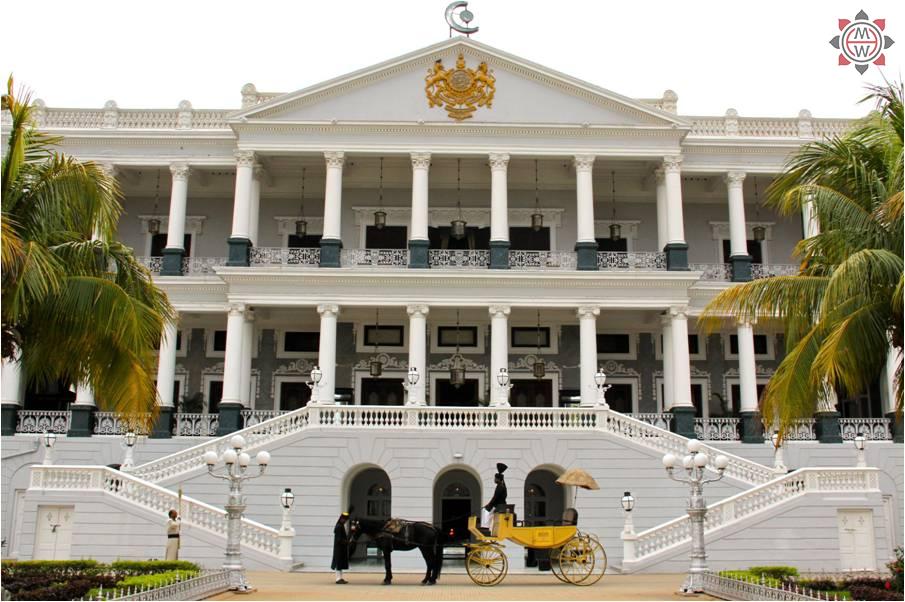
Falaknuma Palace
Falaknuma Palace is one of the finest palaces in Hyderabad. It belonged to Paigah Hyderabad State, and it was later owned by the Nizam of Hyderabad. It is on a 32-acre (13 ha) area. It was built by Nawab Vikar-ul-Umra, prime minister of Hyderabad and the uncle and brother-in-law of the Nizam VI, Nawab Mir Mahboob Ali Khan Bahadur. Falak-numa means "Like the Sky" or "Mirror of the Sky" in Urdu. The palace was mostly kept closed since 1950s and then underwent a huge restoration after it was given on lease to the Taj Group of Hotels. William Ward Marret didn't just design a Palace; he created a space dedicated to the art of perfecting pleasure. Where billiards rooms, smoking rooms, pools, ballrooms, croquet lawns, private gardens, a dining room to seat 101 guests at the world's largest dining table, a library, turret rooms, stables, terraces with views of the city, a private petrol pump and royal garages filled with a fleet of vintage cars serve to be just some of the known pleasures and comforts of this sumptuous royal abode.
Chowmahalla Palace
Chowmahalla Palace is a palace of the Nizams of Hyderabad state. It was initiated by Nizam Salabhat Jung in 1750 and completed by Nizam Afzar-ud-Dawla Bahadur in 1869. It was the seat of the Asaf Jahi dynasty and was the official residence of the Nizams of Hyderabad while they ruled their state. In Persian, Chahar means four and in Arabic Mahalat (plural of Mahal) means palaces, hence the name Chowmahallat/four palaces. The Chowmahalla Palace is a replica of the Shah's Palace in Teheran. As one steps into the palace, the eyes are left bedazzled by the overhead, Belgian crystal-made chandeliers and the mirror-finish, white marble floor.
Necropolis
Qutub Shahi tombs
The Qutub Shahi tombs represent the most authentic and majestic display of the Qutub Shahi dynasty architectural traditions today. The Qutub Shahi tombs make up one of the largest and most unique necropolises in the world. The grandeur of the tombs is ensconced amidst the beautiful and picturesque landscape and gardens of Ibrahim Bagh, and the tombs themselves are dedicated to the seven Qutub Shahi kings who ruled Golconda for nearly 170 years. The tombs are structures with intricately carved stonework and are surrounded by landscaped gardens. All except the last of the Qutub Shahi sultans lie buried here. Sultan Quli Qutub ul Mulk's tomb, the style of which sets the example for the tombs of his descendants, is on an elevated terrace measuring 30 meters in each direction. The tomb was built in 1543 A.D. by the Sultan, during his lifetime, as was the custom.

Paigah Tombs
Paigah Tombs or Maqhbara Shams al-Umara, are the tombs belonging to the nobility of Paigah family, who were fierce loyalists of the Nizams, served as statespeople, philanthropists and generals under and alongside them. The Paigah tombs are known for their architectural excellence as shown in their laid mosaic tiles and craftsmanship work. The Indo-Islamic architecture is a mix of both the Asaf Jahi and the Rajputana styles of architecture. These tombs are 200 years old which represent the final resting places of several generations of the Paigah Nobles. Abdul Fateh Khan Tegh Jung was the first who was buried in 1786 at the place. Though these stunning tombs are strewn over 35-40 acres, tombs of the Paigah as who had married daughters of the Nizams and their spouses are confined to a two-acre site. It is this enclosure which is now known as Paigah tombs. They are in the shape of chaukhandis with latticed panels but open to sky. As all the Nizam's tombs till the ascending to the throne by 7th Nizams were exposed to sky, to emulate the tomb of Mughal emperor Aurangazeb, of whom the Nizam were the governor. So the Paigah nobles preferred their graves to be without any roof.
Protected treasure
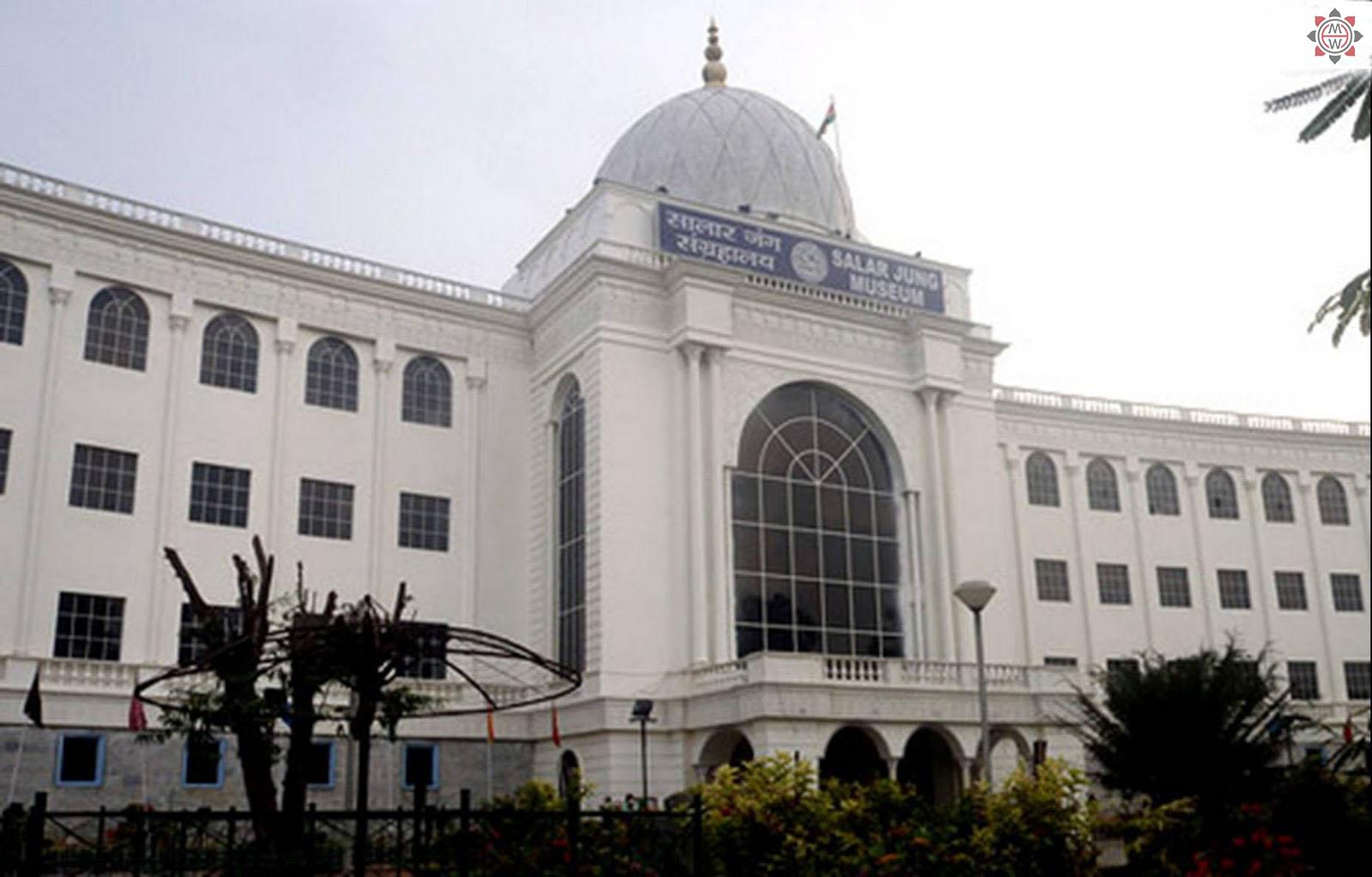
Salarjung Museum
The Salarjung Museum is the third largest museum in India housing the biggest one-man collections of antiques in the world. It is well known for its prized collections belonging to different civilizations. Nawab Mir Yusuf Ali Khan Salar Jung III (1889–1949), former Prime Minister of the seventh Nizam of Hyderabad, spent a substantial amount of his income over thirty-five years to make this priceless collection, his life's passion. The collections left behind in his ancestral palace, 'Diwan Deodi' were formerly exhibited there as a private museum which was inaugurated by Jawaharlal Nehru in 1951. Later in 1968, the museum shifted to its present location at Afzalgunj. Salar Jung III collected about 43,000 artifacts and 50,000 books and manuscripts. The museum building in a semicircular shape with 37 galleries, spread on two floors, displays only a part of the original collections. Each gallery is huge and has many artifacts on display including ones dated back to the 4th century.
Nizam's Museum
The Nizam's Museum is inside the palace of Purani Haveli, the official residence of the Nizam. The wardrobe of HEH Mir Mahbub Ali Khan, the sixth Nizam of Hyderabad (1869-1911), showcases some of the costumes worn in the city during the early 19th century. A truly phenomenal exhibit in its own right, the wardrobe, is 176 ft long and is made of the finest of the Burma teak. It is constructed on two levels. The museum had been created in honor of the last Nizam of the state; it is currently also used as a school for industrial training.
State Museum
The State Museum is situated in Hyderabad’s Public Garden. It has a bright and fresh view of the culture of the state. It is the oldest of all but very well maintained to be kept anew. Archeologist Henry Cousens had explored the place in the 19th Century and later excavated by a Nizam who had decided to place the objects in a museum for which it had been built.
Tribal Museum
The museum brings together culture, lifestyle, customs and beliefs of the various tribes hailing from different districts of Telangana state and Andhra Pradesh. The museum throws light on their heritage and a way of life which is simple yet vibrant. Stories are told through pictures, literature and the figurines that as displayed.
Car museum
Hyderabad has its first and only car museum in the world. This museum is the brainchild of K Sudhakar who got hooked onto this hobby right from his childhood. This museum houses an enviable collection of mini bikes, cycles, buses and cars in all possible shapes and sizes. There are three galleries in the museum. While the first one has an assortment of replicas of cars, race cars, and cycles that one would normally see on the road, the second and third galleries have a collection of whacky designs. The designs of the cars and bikes have been inspired by all sorts of things ranging from basketball, football, desktop computer, fountain pen, billiards table, flowers, bed, western style commode, brinjal, camera, saucer, and helmet among other objects. One of the best places to have a fun filled day with children, this museum is definitely one of the most innovative museums in Hyderabad. K. Sudharkar is also the Guinness World Record holder for the tallest Tri-cycle.
Faith factor
Though Hindus form a majority of the Hyderabad population, Muslims have substantial presence across the city and are predominant in and around the Old City. The other religious communities are Christian, Sikh, Jain, Buddhist and Parsi. Iconic temples, mosques and churches are housed in the city. The Hyderabad city religious statistics of 2011 census are: Hindus (70%), Muslims (27%), Christians (2.5%), Sikhs (0.2%), Buddhists (0.04%), Jains (0.04%) and remaining others.
Note on the dress code: While visiting these sacred places, ladies should dress conservatively and carry a scarf or dupatta to cover their head. Gents should wear trousers.
Sacred places of Hindus
Hyderabad has innumerable temples. Here are some of the frequently visited ones.
Birla Mandir
A beautiful temple made of white marble, dedicated to Lord Venkateshwara / Balaji, built on a 280 feet high hillock called Naubath Pahad, overlooking the city.
Sanghi Temple
A temple dedicated to Lord Venkateshwara / Balaji; graces a promontory overlooking Sanghi Nagar, near Ramoji Film City.
Chilkur Balaji Temple
It is a temple of Lord Venketeshwara / Balaji. It is popularly known as the "Visa Balaji Temple''.
Jagannath Temple
This temple is dedicated to the Hindu God Jagannath. This temple in Hyderabad is said to be replica of the original Jagannath Temple of Puri (Orissa) in context of design. It is famous for its annual Rathyatra festival attended by thousands of devotees.
ISKCON temple
Hyderabad is the South Indian headquarters for ISKCON (The International Society for Krishna Consciousness) in India. The magnificent Sri Sri Radha-Madana-mohana temple in Nampally, serves as a center of the cultural, spiritual, educational and social activities given to uplift the lives of people here.
Gaushalas or Goshalas
These are protective shelters for cows in India. Goshalas focus on treating cows well out of their religious significance in Hinduism and consequent cultural sensitivity towards their welfare. A visit to a Goshala, provides an experience of the rituals around worshipping, feeding, housing and touching the holy cow, believed to bring prosperity and good health.
Surendrapuri - Indian Mythological Awareness Cente
Surendrapuri was established by Kunda Satyanarayana in memory of his son Surendra. It contains nearly full sized replicas of almost all the important Hindu temples in India. The architecture of the temple and the sculptures make one feel as if one is in the actual holy place. There are a few hundred such replicas. The sculptures depict stories from epics like Ramayan, Mahabharat, and Bhagavat.
For the religious minded, it provides satisfaction of having visited all the Hindu holy places in India in one short trip of about 3-4 hours. For the curious minded, it provides a good visual background of what Hindu mythology is all about. One does not have to be religious to visit this place.
The Ammapalli temple and Step well
The Ammapalli temple was built during the time of Kalyani Chalukyas, who ruled the region between 7th and 12th century AD. The gali gopuram is a magnificent work of art that rises 80 feet and incorporates elements of Rajasthani architecture such as the flared chajjas that curve upwards. The three idols of Sita, Rama and Lakshmana were carved out of a single stone. Spread over nine acres, the temple has a step well that sprawls over an acre of land and has a walkway around it.
Statue of Equality
Born in 1017 in Sriperumbudur in Tamil Nadu, Ramanujacharya
is revered as a Vedic philosopher and social reformer. He travelled across
India, advocating equality and social justice. The 216-foot-tall statue, is
located at the 45-acre scenic Jeeyar Integrated Vedic Academy (JIVA) on the
outskirts of Hyderabad.
Ramanuja was an advocate of social equality among all
sections of people centuries ago, and encouraged temples to open their doors to
everyone irrespective of caste or position in society at a time when people of
many castes were forbidden from entering them. He took education to those who
were deprived of it. His greatest contribution is the propagation of the
concept of “vasudhaiva kutumbakam”, which translates as “all the universe is
one family”.
Sacred places of Muslims
Makkah Masjid
It is one of the oldest mosques in Hyderabad, and one of the largest in India. Muhammad Quli Qutb Shah, the fifth ruler of the Qutb Shahi dynasty, commissioned bricks to be made from the soil brought from Mecca, the holiest site of Islam, and used them in the construction of the central arch of the mosque, thus giving the mosque its name.
Shahi Masjid
A majestic mosque and popular pilgrimage center located inside the Public Gardens, one of oldest gardens in Hyderabad that was built in 1846 during the Nizam rule. The last Nizam used to come here with his family members on Fridays and during special festivals like Eid to offer prayers, thus giving the mosque its name, Shahi Masjid or Royal Mosque.
Maula Ali Durgah
The Moula Ali dargah is located on top of a hill that takes 500 steps to climb. It was built by Sultan Ibrahim Qutub Shah and it is the only dargah dedicated to Hazrat Ali, son-in-law of Prophet Muhammad and the fourth Caliph. Its interior is decorated with thousands of mirrors and it is one of the 11 heritage sites in Hyderabad, identified by the "Heritage conservation committee" of HUDA.
Saidanima's Tomb
The Saidanima’s Tomb was built by Abdul Haq Diler Jung, a high ranking official in 1883, in memory of his mother, Hazrath Saidanima Saheba. The magnificent façade, ornately carved dome and elaborate stucco decorations is reminiscent of the Mughal and Qutb Shahi architecture.
Dargah Yousufain (Nampally Dargah)
Syed Shah Yousufuddin and Syed Shah Sharifuddin were commanders in the army of Aurangzeb. The Moghal emperor, according to legend, Aurangzeb, sought help of Syed Shah Yousufuddin and Syed Shah Sharifuddin, to conquer the Kingdom of Golconda. When they died, they were buried in Nampally in Hyderabad. Since then the dargah is popular with followers of all faiths coming from all classes of society.
Badshahi Ashurkhana
Badshahi Ashurkhana is a mourning place for Shias during the festival of Moharram. It was constructed in memory of martyrdom of Imam Hussain, built by Muhammed Quli Qutb Shah in 1594, three years after building the Charminar. It is now classified as a heritage site and is looked after by the ancestral hereditary Mutawalli Mujawer Mir Nawazish Ali Moosvi 11 generations custodian along with state Department of Archaeology and Museums.
Sacred places of Christians
St. George's Church
It is one of the oldest churches and has been certified in the list of heritage buildings in Hyderabad. The choir is one of the most popular in the city consisting of some soulful singers from all age groups. The very famous St. George’s Grammar School and College is
associated with it.
St. Joseph’s Cathedral
Located very near to St. George’s is the very visually appealing catholic church namely St. Joseph’s Cathedral. In 1869 Fr. Antonio Tagliabue bought a plot in Gunfowndry to build a church, school and a convent which is now famously known as Rosary Convent.
All Saints Church
This stunning church was built in the 18th century under the British Colonial rule and was mainly attended by the army people. It is now under the auspices of the CSI (Church of South India) and has converted into a Tamil Anglican church. It’s got a stained glass altar with Christ on the Holy Cross and looks extremely wonderful.
Centenary Methodist Church
One of the largest churches in Hyderabad, the current structure of which was built in the seventies. It’s a Protestant Church.
Millennium Methodist Church
Previously just a small chapel built in 1883; it was then demolished in the new millennium (2001) for a larger structure as the Methodists in the city were increasing in number and hence got its name. It’s mainly a youth church with many youngsters attending and conducting events and services every week.
St. John’s The Baptist Church
One of the oldest churches in the city, famously known as St. John’s was built in 1813. It was originally attended by the British forces but now is an Anglican church attended by many Christians residing in the city.
St. Mary's Church
It is considered to be the most popular churches in Secunderabad and is well attended. It’s a Gothic styled Roman Catholic Church devoted to Mother Mary but formerly belonged to the Cathedral of Archdiocese of Hyderabad. The church has been bestowed by the Vatican as the ‘Minor Basilica’, a title given to Roman Catholic churches based on the Canon Law. A huge statue of The Virgin Mary holding Jesus Christ in her arms captures the eye as you walk in.
Wesley Church
Built in 1916 by the British missionaries, this vintage looking church is located near the famous Clock Tower of Secunderabad. One of the prominent churches in the city, it gives you peace and calmness as you sit here to worship the Lord.
Medak Cathedral
Medak Cathedral is the seat of the Bishop in Medak for the Church of South India (comprising Wesleyan Methodist, Congregational and Anglican missionary societies - SPG, WMMS, LMS, CMS, and the Church of England).
The Cathedral is the largest of all churches in Telangana. The Cathedral also sees over the Diocese of Medak, which is the single largest diocese in Asia and the second largest diocese in the world. It was consecrated on 25 December 1924, built by the British Wesleyan Methodists. It has a notable architecture and prominent gothic structure. The stained glass windows depict the birth, crucifixion and ascension of Jesus Christ.
Other sacred places
Ananda Buddha Vihara
Ananda Buddha Vihara is a Buddhist religious place and cultural center for training Buddhism in an area of 3 acres on top of a small hill, offering one of the best views of the city. You would be astonished by the calm serenity of this place. The Vihara was inaugurated by 14th Dalai Lama named Tenzin Gyatso in 2002. Ananda Buddha Vihara Trust is a committee which looks after the cause of reviving, preserving and spreading Buddhist tradition and culture. This trust was first setup in 1988.
Gurudwara - Guru Nanak Jhira Sahib, Bidar
The Gurudwara - Guru Nanak Jhira Sahib, is established in a nice valley, surrounded by laterite hills on three sides, in Bidar, Karnataka, about 130 kms (3 hours) from Hyderabad. The shrine comprises Darbar Sahib, Diwan Hall and Langar Hall. The beautiful Gurdwara was constructed in 1948 by the side of a spring. The water from the spring is collected in a small Amrit Kund (a holy water tank) built opposite to the front stairs of the Gurudwara . It is believed that a holy dip is enough to cleanse the body as well as the soul. There is a free community kitchen (Guru Ka Langar) where free food is given to pilgrims 24 hours night and day. A Sikh museum has been built in the memory of Guru Tegh Bahadur, depicting the important events of Sikh history through pictures and paintings.
A trip to Bidar can also include a visit to the Bidar Fort.
The Ramakrishna Math
The Ramakrishna Math has a beautiful temple dedicated to Bhagawan Sri Ramakrishna Paramahamsa. This is a universal temple in the sense that all people, irrespective of religion, caste, creed, race, sex and nationality are welcome here. They can participate in the worship, bhajans, arati etc, or engage themselves in silent prayer or meditation. This temple is a place where anyone who needs a favorable atmosphere to dive deep into oneself through meditation or prayer or vichara (self-enquiry).
Nagarjunakonda - a historical Buddhist town
Nagarjunakonda is known as one of the richest Buddhist Learning Centre and has many caves that exhibit Buddhist carvings. Nagarjunakonda was the capital of Ikshvaku Kingdom and was called Vijayapuri. It is the third most important cultural centre of South India, and is surrounded by world's third largest man-made Lake Nagarjunasagar Lake (about 185 kms, 4 hours from Hyderabad).
A six year long major excavation had to be taken place in order to save the relics from being flooded by the formation of NagarjunaSagar. The excavation resulted in detection many Buddhist ruins, stupas, temples, pillared pavilions, white marble statue of Buddha, coins, jewelry and many more ruins. A. R. Saraswati was the first Archaeologist to have discovered the ruins of Nagarjunakonda in the year 1926. During the excavation Paleolithic and Neolithic Era's Stone Age tools were discovered.














